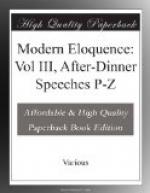MR. PRESIDENT, MY LORDS, AND GENTLEMEN:—You have been pleased to confer upon me two of the greatest honors which this country can possibly bestow upon a foreigner—first, by your kind invitation to this hospitable banquet to meet the most illustrious statesmen, the most eminent scholars, and the most distinguished artists; and secondly, by your toast to my health. In warmly thanking you, I feel the greatest satisfaction to think that for these signal honors, I am solely indebted to my labors in Troy and Mycenae. ["Hear! Hear!”]
In Troy art was only in its first dawn; color was still completely unknown, and instead of painting, the vases were decorated with incised patterns filled with white clay. The productions of sculpture were limited to carving of small flat idols of Minerva [Greek: glaukopis][6] of marble, almost in the forms of two discs, which adhered to each other, and upon which the owl’s face is rudely scratched. The Trojan treasure certainly shows more art, but it is characterized by an absence of ornamentation. In Mycenae, on the contrary, the monuments which I have brought to light show a high state of civilization, and the skill with which the gold ornaments are made leads us to pre-suppose a school of domestic artists which had flourished for ages before it reached such perfection.
The very great symmetry we see also in the vase-paintings and in the carvings of spirals and rosettes on stone, whereas representations of men or animals are exceedingly rude and appear to be the primitive Mycenean sculptor’s first essay. But rude as they are, and childish as they look, these primitive productions of Greek art are of paramount interest to science, because we see in them the great-grandfathers of the masterpieces of Phidias and Praxiteles; they prove to us in the most certain manner that the artistic genius of the epoch of Pericles did not come suddenly down from heaven like Minerva from the head of Jove, but that it was the result of a school of artists, which had gradually developed in the course of ages.




